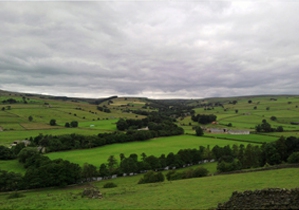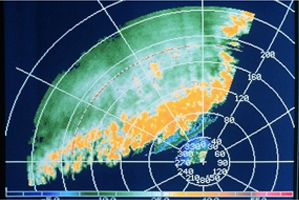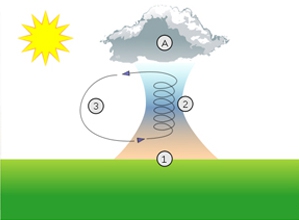Balloon Weather
Getting the right conditions and weather for hot air balloon flights
 Many of our balloon ride passengers fly on their first attempt but for others it can take a few tries. It really is down to luck. Yearly and monthly the weather is different. So hot air ballooning can take a bit of patience but the more bookings you make the quicker you will get airborne and the experience is always worth the wait.
Many of our balloon ride passengers fly on their first attempt but for others it can take a few tries. It really is down to luck. Yearly and monthly the weather is different. So hot air ballooning can take a bit of patience but the more bookings you make the quicker you will get airborne and the experience is always worth the wait.
Our Ballooning FAQ's page tells you that for a balloon flight we need light winds, good visibility and no rain. Whilst these are what we need, what our passengers would probably like to know is when these weather conditions for ballooning are most likely to occur.
The position of the British Isles on the edge of the Atlantic Ocean has meant that traditionally we have low pressure weather systems in the winter and more high pressure systems in the summer. The high pressure weather will generally give us blue skies, light winds and little rain. The low pressure systems often have storms, rain and strong winds associated with them. So the hot air balloon rides season runs from April to October and the man in the street probably thinks that the best weather for ballooning is about "harvest time" in July and August. We will talk more about the changing weather patterns later, but first let's look at the "light winds, good visibility and no rain".
Click here for hot air balloon ride prices
Predicting the wind
 Hot air balloon flights rely on the wind being light for the first few hours after dawn and to decrease before dusk. Both of these situations can provide the opportunity for an enjoyable and safe balloon flight. For a safe balloon flight surface winds must be less than 10 miles an hour during the hour after dawn or before dusk. Of course we have to let our passengers know well before so we have to use forecasts and rely on this information to be able to make the decision to call the flight on. Sometimes the forecast will be wrong and we may on rare occasions have to cancel at the launch site because conditions just don't work out as the forecasters would have us believe. Or conversely we may end up cancelling a flight that turns out to be flyable, but only with the benefit of hindsight because it was just not predictable with any confidence.
Hot air balloon flights rely on the wind being light for the first few hours after dawn and to decrease before dusk. Both of these situations can provide the opportunity for an enjoyable and safe balloon flight. For a safe balloon flight surface winds must be less than 10 miles an hour during the hour after dawn or before dusk. Of course we have to let our passengers know well before so we have to use forecasts and rely on this information to be able to make the decision to call the flight on. Sometimes the forecast will be wrong and we may on rare occasions have to cancel at the launch site because conditions just don't work out as the forecasters would have us believe. Or conversely we may end up cancelling a flight that turns out to be flyable, but only with the benefit of hindsight because it was just not predictable with any confidence.
Web sites like www.xcweather.co.uk can be helpful in giving a general picture of what the weather is going to do, but your balloon pilot will need more detailed information in special balloon flight forecasts that give the wind speeds in the upper levels at 500, 1000 and 2000 feet above the ground. These will tell us if just above the otherwise pleasant 5 mile an hour forecast for the wind on the surface there is for example turbulence and wind shear at 3-500 feet above the ground that might cause great difficulty in making a smooth and safe balloon flight landing. Remember a hot air balloon is over 100 feet high and if the wind is blowing part of it at a different speed to the rest of the balloon, the distortion of the balloon is not a pleasant experience and could result in a very bumpy and potentially injurious landing.
Predicting if the wind will be very light or far too strong is relatively easy and can often be seen some days ahead as high or low pressure weather systems approach. If light winds can be seen ahead, we will text passengers of any remaining spaces if they are on our standby list and sometimes we will put on an extra flight.
If strong winds are the overriding factor in deciding to cancel a flight, sometimes we may be able to give you advanced notification by text as we appreciate that having a balloon flight cancelled is a frustrating and disruptive event for our passengers. So do make sure that we have your mobile number!
Predicting the visibility
This can be more of an issue for balloon flights in Spring and Autumn when conditions are generally cooler and there is more moisture in the air because of recent rain. These conditions can give rise to mist, fog or ultimately low cloud. It is more of an issue in the morning but equally a little mist on the surface can give rise to a magical effect for the first part of a early morning balloon flight before the sun's heat burns it off.
Visibility can be very difficult to predict and is probably the most commonly occurring error in weather forecasts. The different conditions to form mist, fog or low cloud are so subtle that they can vary within a few miles, with a low lying valley area for example being fogged in and a neighbouring area of elevated land being as clear as a bell.
If visibility issues are relevant to the forecast, our balloon pilot's will want to access the most up to date information and may also rely on local knowledge. Indeed retired forecasters who used to work with the Royal Air Force always tell us that they would never give visibility forecasts until 3am in the morning!
Sometimes a forecast of a misty morning with low cloud will be based on the expectation that there will be some overnight rain. Depending on where the rain falls will dictate which areas have excessive moisture in the air to form low lying cloud which would make a balloon flight unsafe and not very enjoyable.
Equally contrary to expectations, in the summer after two or three days of a high pressure system staying right over the centre of the country, the light winds and no rain result in atmospheric pollution with very fine particles which create hazy conditions which get worse the higher you go.
Predicting rain
 Customers ask us what it is like to fly in the rain in a hot air balloon. Getting caught out once is normally enough to cure a balloon pilot of risking flying in the rain. With the top of the balloon at nearly 100 degrees Centigrade (the boiling point of water), when the rain falls on the balloon it cools it. So the pilot has to put in extra heat from the burners to compensate for the heat loss with the steam coming off the top of the balloon envelope otherwise the balloon will descend rapidly. This is bad for the balloon fabric and makes the balloon much harder to control. If there is enough rain it adds to the weight of the balloon (so more heat required!) runs down the side of the balloon and drips into the basket giving all a luke warm gentle shower! And packing the balloon away after is a soggy affair.
Customers ask us what it is like to fly in the rain in a hot air balloon. Getting caught out once is normally enough to cure a balloon pilot of risking flying in the rain. With the top of the balloon at nearly 100 degrees Centigrade (the boiling point of water), when the rain falls on the balloon it cools it. So the pilot has to put in extra heat from the burners to compensate for the heat loss with the steam coming off the top of the balloon envelope otherwise the balloon will descend rapidly. This is bad for the balloon fabric and makes the balloon much harder to control. If there is enough rain it adds to the weight of the balloon (so more heat required!) runs down the side of the balloon and drips into the basket giving all a luke warm gentle shower! And packing the balloon away after is a soggy affair.
So having established that ballooning and rain do not go together how can we predict rain? Well rain is formed because of sections of overly moist air that have "instability" in them formed by temperature changes. These can occur because of heating by the sun and produce showers or thunderstorms once the sun gets up. Or they can occur because a wide section of air called a trough or a front some hundreds of miles across is moving towards the country on the prevailing wind. (See the following page for more detailed information about rain http://en.wikipedia.org/wiki/Rain)
Summer showers will often die off as the temperature from the sun (which has triggered them in the first place) reduces when evening approaches so for ballooning it is a case of watching the weather radar closely to see where the showers are forming, where they are tracking and if they are beginning to die away. So for this sort of situation our pilots may ask you to call back a little later when it will be easier to predict what the rain will do.
Thunderstorms are not good for any form of aviation and especially balloons. Thunderstorms are caused by massive changes in temperature in moist air giving rise to severe air currents that would pick up a hot air balloon and lift it thousands of feet up in the air in minutes. But because thunderstorms are generally isolated and often associated with light winds, again it is a case of watching the weather radar closely to see how active they are and where they are forming on the day.
Troughs and fronts can be seen moving across the country on the weather radar and sometimes it is possible to fly in the benign conditions before them or the lovely clear air that can occur just an hour after they have gone through. Indeed when their progress is clear and precise we make some of our best London flights just before a high pressure builds or before a low pressure system moves in. Equally sometimes their travel is clear and precise and sometimes it is very fragmented and difficult to predict.
Changes in out climate
Changes in the weather since 2006 have meant that high pressure systems associated with sunny summer "barbecue" weather have been shorter lived and often associated with summer storms and wet spells. This is because they have not travelled as far north as they would normally and as a consequence do not cover the whole of the country. Whilst they have given us sunny days, they have not given us the light winds that we would expect if the high pressure system were centred over the UK. As a result there have been nice days with lots of sunshine but with winds that are above the safe limits for hot air balloon flights. When balloon rides are cancelled on days like this it can be difficult for customers to understand why. We are not sure if the poorer summers we have had over the last 5 years represent a long term change or a blip that will return to "normal" next year.
More weather questions
Why don't hot air balloons fly during the day?
 When surface winds are calm, hot air balloon ride pilots can control the altitude of the balloon very finely by heating or venting the air inside. During the day these light surface winds are broken up by "thermals" (See the following page for more detailed information http://en.wikipedia.org/wiki/Thermals) These are rising columns of warm air that spiral skywards, caused by the heating effect of the sun on the ground. Birds and glider pilots love them but for a hot air balloon which is nothing more than a fancy paper bag thermals make it very hard to control the balloon. So the hotter the day the greater the problem.
When surface winds are calm, hot air balloon ride pilots can control the altitude of the balloon very finely by heating or venting the air inside. During the day these light surface winds are broken up by "thermals" (See the following page for more detailed information http://en.wikipedia.org/wiki/Thermals) These are rising columns of warm air that spiral skywards, caused by the heating effect of the sun on the ground. Birds and glider pilots love them but for a hot air balloon which is nothing more than a fancy paper bag thermals make it very hard to control the balloon. So the hotter the day the greater the problem.
Even without the sun's effect the surface winds increase soon after dawn because the upper winds which are generally faster start to mix up the surface winds and make them gusty and unpredictable. Just think of washing flapping on a clothes line or a flag.
Our balloon flight was cancelled and we saw ballons flying?
Firstly every balloon flights pilot has to make their own judgement of the conditions in which they are confident to fly passengers. Secondly most passengers are expecting to fly for about an hour and sometimes it might be possible to fly but only if you are prepared to accept a short flight. In general our pilots will try to avoid putting our passengers in this situation. We have to put our "decision" on our phone lines well before the flight and therefore have to use forecasts.
For a group of balloon enthusiasts flying their own balloon who do not have the responsibility of flying passengers and are not so worried whether they fly or not, the opportunity will often exist to go to a balloon launch site and just wait for the wind to drop. If it does they fly and if not they probably go to the pub next door to console themselves and relive the experiences of some of their recent flights! To an experienced private balloonist a fast but short flight of just 20 minutes can be great fun, especially if the landing is fast and bumpy. They are used to these situations, our passengers are generally doing it all for the first time and don't really know what to expect on landing and may be much older (or younger) than the average balloon enthusiast.
What is the best month for balloon flights?
There is no longer a simple answer to this question. Ten years ago it would have been fair to say that July, August and September had some of the best weather for ballooning. In the past 5 years weather conditions have been generally poorer in the summer months and much better in April and often good in October. Of course next year could turn that all around. We encourage passengers to start booking flights as soon as they have received their voucher as if you have read this far down the page you will now understand why! Whenever you choose to fly you can be sure that your Adventure Balloons pilot will make sure you have light winds, no rain and good visibility to ensure you have a safe and enjoyable flight.






